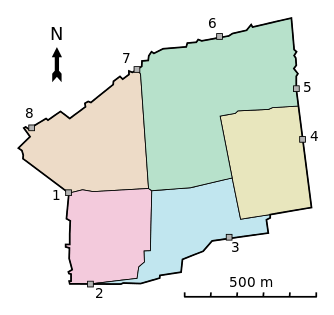Dome of the Prophet
The Dome of the Prophet (Arabic: قبة النبي, Qubbat an-Nabi) is also known as the Dome of the Messenger and the Dome of Muhammed[1] is a free-standing dome in the northern Al-Haram Al-Sharif in Quds .It is a part of the terrace of the Dome of the Rock and locate the northwest of it in the Al-Haram Al-Sharif.
.jpg)
History
Originally, the Dome of the Prophet, which date back to before Crusader period[2], was rebuilt by Muhammad Bey, Ottoman Governor of Al-Quds Al-Sharif in1539 its dome, in the time of Kanuni Sultan Süleyman.[3][4] Its last renowate was made in the reign of Sultan Abdul Majid II.
Several Muslim writers, most notably al-Suyuti and al-Vâsıtî claimed that the site of the dome is where Muhammad led the former prophets and angels in prayer on the night of Isra and Mir'aj before ascending to Heaven. [5][1][6][7][8]Endowment documents from the Ottoman period indicate that a portion of the endowment of the al-Aqsa Mosque and Haseki Sultan Imaret [9]was dedicated to maintain the lighting of an oil-lamp in the Dome of the Prophet each night.[10][5]
Architecture
The Dome of the Prophet's octagonal structure is built atop eight gray marble columns.[11] The dome, which is covered with sheet lead and being without walls[6], is hemispherical and is supported by pointed arches decorated with red, black and white stones. The ancient mihrab is made of a white marble slab embedded in the floor and surrounded by red-colored stones and subsequently delimited by a low wall, that traditionally opened in the north to allow entrance of Muslim believers heading southward to Mecca in Muslim prayers.[12][10]
References
- Kaplony, Andreas (2002). The Ḥaram of Jerusalem (324-1099): Temple, Friday Mosque, Area of Spiritual Power. Zurich: Franz Steiner Verlag. p. 84. ISBN 978-3515079013.
- Elad, Amikam (1999). Medieval Jerusalem and Islamic Worship: Holy Places, Ceremonies, Pilgrimage. Netherlands: Brill. pp. 307, 308. ISBN 9004100105.
- Dome of the Prophet Noble Sanctuary Online Guide.
- Aslan, Halide. "Osmanlı Döneminde Kudüs'teki İlmî Hayat". Journal of Islamic Research. 2015;26(3):93-9: 94.
- Uğurluel, Talha (2017). Arzın Kapısı Kudüs. Istanbul: Timaş. p. 289. ISBN 978-605-08-2425-4.
- Le Strange, Guy (1890). Palestine Under The Moslems. pp. 123, 154, 155.
- Armstrong, Karen. "Sacred Space: The Holiness of IslamicJerusalem". Journal of IslamicJerusalem Studies. 1(1): 5–20.
- Çalı, Erol (2018). Hüznün Başkenti Kudüs. İstanbul: Destek Yayınları. p. 249. ISBN 9786053113508.
- Haseki Sultan Imaret
- Al Masjidul Aqsa Site Plan Archived October 6, 2008, at the Wayback Machine Al-Aqsa Friends 2007.
- Jacobs, Daniel. Israel and the Palestinian Territories Rough Guides, p.350. ISBN 1-85828-248-9.
- Prophet's Dome Archived May 7, 2008, at the Wayback Machine Archnet Digital Library.

